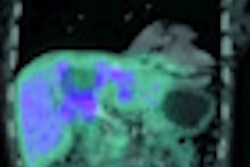
Combining pulsed nonthermal focused ultrasound with radiotherapy could increase the efficacy of prostate cancer treatment, according to a presentation at the American Association of Physicists in Medicine (AAPM) annual meeting held in Charlotte, NC, earlier this month.
There are many benefits to the use of focused ultrasound as a therapeutic modality: The treatment is easily image-guided, noninvasive, and can be repeated with no cumulative side effects. Currently, high-intensity focused ultrasound is employed for thermal ablation of tumor lesions, while the nonthermal form (where tissue is not heated above 42° C) is employed for drug delivery.
But could nonthermal pulsed focused ultrasound (pFUS) find application elsewhere? Xiaoming Chen, PhD, a medical physicist at Fox Chase Cancer Center, presented a study investigating the combined use of radiotherapy and pFUS for prostate cancer treatment.
Radiation therapy is currently the standard treatment for prostate cancer, with technologies such as image-guided and intensity-modulated radiotherapy allowing the use of higher target doses. However, higher doses will inevitably increase treatment side effects. "It is our aim to use a lower radiation dose and combine radiation therapy with other treatments to maintain treatment efficacy," Chen explained.
Pulses of focused ultrasound create large periodic negative pressures at their focus, which can induce microbubbles. Oscillation or collapse of these bubbles gives rise to localized bioeffects, including cell killing. Thus Chen surmised that nonthermal pFUS may increase the efficacy of radiotherapy. Another critical motivation is the fact that, unlike radiotherapy, pFUS is not affected by the presence of hypoxia.
In vivo comparison
Chen and colleagues tested their hypothesis using an animal prostate tumor model. Eight tumor-bearing mice were randomly assigned to receive pFUS, pFUS plus radiotherapy, or no treatment.
MR-guided pFUS was delivered in four to eight 60-sec sonications (to cover the entire tumor volume), using 1-MHz, 25-W, 10%-duty-cycle focused ultrasound. MR thermometry was employed during treatment to ensure the local temperature remained below 42° C. For the combined treatment, radiotherapy to a dose of 2 Gy was performed within 30 minutes of the pFUS.
Following treatment, the team used weekly MR imaging to measure the tumor volume. Tumors in the control group increased exponentially in size, from 121 mm3 on the treatment day to 500 mm3 at four weeks post-treatment. Tumor volumes in the pFUS group decreased by 33%, 29%, 14%, and 15%, at one, two, three, and four weeks post-treatment, respectively. The pFUS plus radiotherapy group showed a greater response, with volume reductions of 31%, 31%, 26%, and 33% at weeks one to four.
"Pulsed FUS combined with radiotherapy can significantly delay tumor growth," Chen concluded. He explained that the mechanism of tumor cell killing may differ between the two modalities, as pFUS shows early tumor growth delay while radiotherapy contributes to late effects on tumor control.
More recently, the researchers also studied the effects of radiotherapy alone on this animal tumor model. Chen noted that the effect of 2-Gy radiotherapy lay between that of pFUS and the combination treatment.
Chen's co-authors include Dusica Cvetkovic, Jun Xue, Lili Chen, and C-M Charlie Ma from Fox Chase Cancer Center.
© IOP Publishing Limited. Republished with permission from medicalphysicsweb, a community website covering fundamental research and emerging technologies in medical imaging and radiation therapy.



















